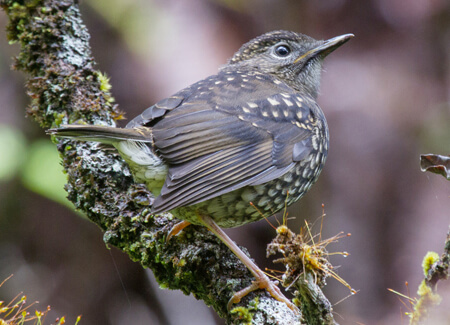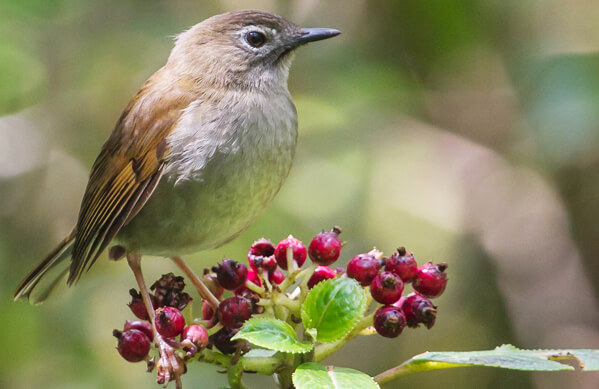 The Puaiohi, or Small Kauaʻi Thrush, is only found in the Alakaʻi Wilderness Preserve on the Hawaiian Island of Kaua‘i. Its Hawaiian name comes from the high-pitched call males give repeatedly at twilight.
The Puaiohi, or Small Kauaʻi Thrush, is only found in the Alakaʻi Wilderness Preserve on the Hawaiian Island of Kaua‘i. Its Hawaiian name comes from the high-pitched call males give repeatedly at twilight.
The Puaiohi is threatened by introduced mammals – particularly rats, which prey on eggs and nestlings. Introduced pigs, goats, and plants also degrade the Puaiohi's habitat. Non-native avian diseases spread by invasive mosquitos are a concern, too, but Hawai‘i's thrushes show more tolerance to avian malaria than the highly susceptible honeycreepers.
Bird on the Brink
The Puaiohi was added to the U.S. Endangered Species List in 1967. It is one of two endemic thrushes that persist in Hawai‘i today; the other is the ʻŌmaʻo, found only on the Big Island. The other endemic thrush species, the Kāmaʻo (Large Kauaʻi Thrush), ‘Āmaui, and the Olomaʻo, were driven to extinction by the same threats which have brought the Puaiohi to the brink.
Puaiohi mostly eat the fruits of native plant species and help disperse their seeds. They prefer forested, steep-sided ravines for nesting, where ferns and mosses provide a high level of cover from native and introduced predators. This species often will re-nest when a nest fails, and can fledge up to four broods in a season.
Sign up for ABC's eNews to learn how you can help protect birds

Puaiohi by Robby Kohley
Steps to Save the Species
In 2009, ABC established its Hawai‘i Program, a long-term conservation effort aimed at reversing the decline of endangered Hawaiian birds such as the Puaiohi, Palila, Millerbird, and Hawaiian Petrel.
San Diego Zoo Global began a successful captive breeding program for the Puaiohi in 1996, and has released more than 220 birds into the wild. Artificial nest boxes put up in 2007 by Pacific Rim Conservation and the Hawai‘i Division of Forestry and Wildlife's Kaua‘i Forest Birds Recovery Project (KFBRP) have provided additional nesting sites.
ABC has supported the KFBRP's rat trapping in the Alaka‘i to protect the Puaiohi and other native forest birds such as the ‘Akikiki and ‘Akeke‘e. KFBRP is expanding these efforts, and recently held a successful “Birds, Not Rats!” crowdfunding campaign, which raised more than $27,000 to purchase 100 high-tech rat traps to protect these endemic species across 125 acres of remote forest.
Donate to support ABC's conservation mission!



















































